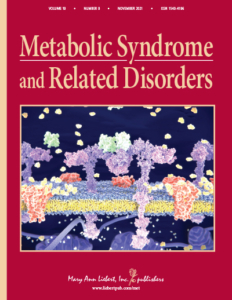Determinants of Incident Metabolic Syndrome in a Middle Eastern Population: Isfahan Cohort Study
Authors
Affiliations
Abstract
Background: To identify the associated risk factors with development of metabolic syndrome (MetS) in a longitudinal prospective cohort study in an Iranian population.
Methods: A total of 1994 participants, aged ≥35 years, free of MetS, diabetes, and cardiovascular disease at baseline were followed up for 7 years. Physical examination, laboratory studies, and interview about lifestyle factors were performed, and MetS was defined based on harmonized definition at both time points. Logistic regression was used to calculate odds ratio (OR) and corresponding 95% confidence interval (CI).
Results: MetS occurred in 27% of subjects with an incidence rate of 39.2 and 46.6 per 1000 person-year in men and women, respectively (P = 0.04). Among the components of MetS, triglyceride (TG) alone (OR 2.59, 95% CI 1.78-3.78) or in combination with waist circumference (WC; OR 5.01, 95% CI 3.59-7.01) was the strongest predictor of incident MetS compared to those free of components. In multivariable analysis, all components were associated with higher risk except fasting plasma glucose in both genders and high-density lipoprotein cholesterol in men. Impaired glucose tolerance was associated with two (95% CI 1.11-3.65) times increased risk in women. The multivariable adjusted OR (95% CI) of overweight and obesity was 1.68 (1.13-2.50) and 2.88 (1.73-4.78) in women and 2.46 (1.74-3.46) and 2.47 (1.38-4.43) in men, respectively. Unhealthy diet [1.57 (1.02-2.41)] and weekly Cola consumption [1.50 (1.05, 2.14)] increased the risk in women only.
Conclusions: TG and WC components showed the highest predictive values for MetS incidence, while general obesity was independently associated with it.
Keywords: glucose intolerance; incidence; metabolic syndrome; obesity; risk factor.
How to Cite
. 2017 Sep;15(7):354-362. doi: 10.1089/met.2016.0156. PMID: 28677982.

